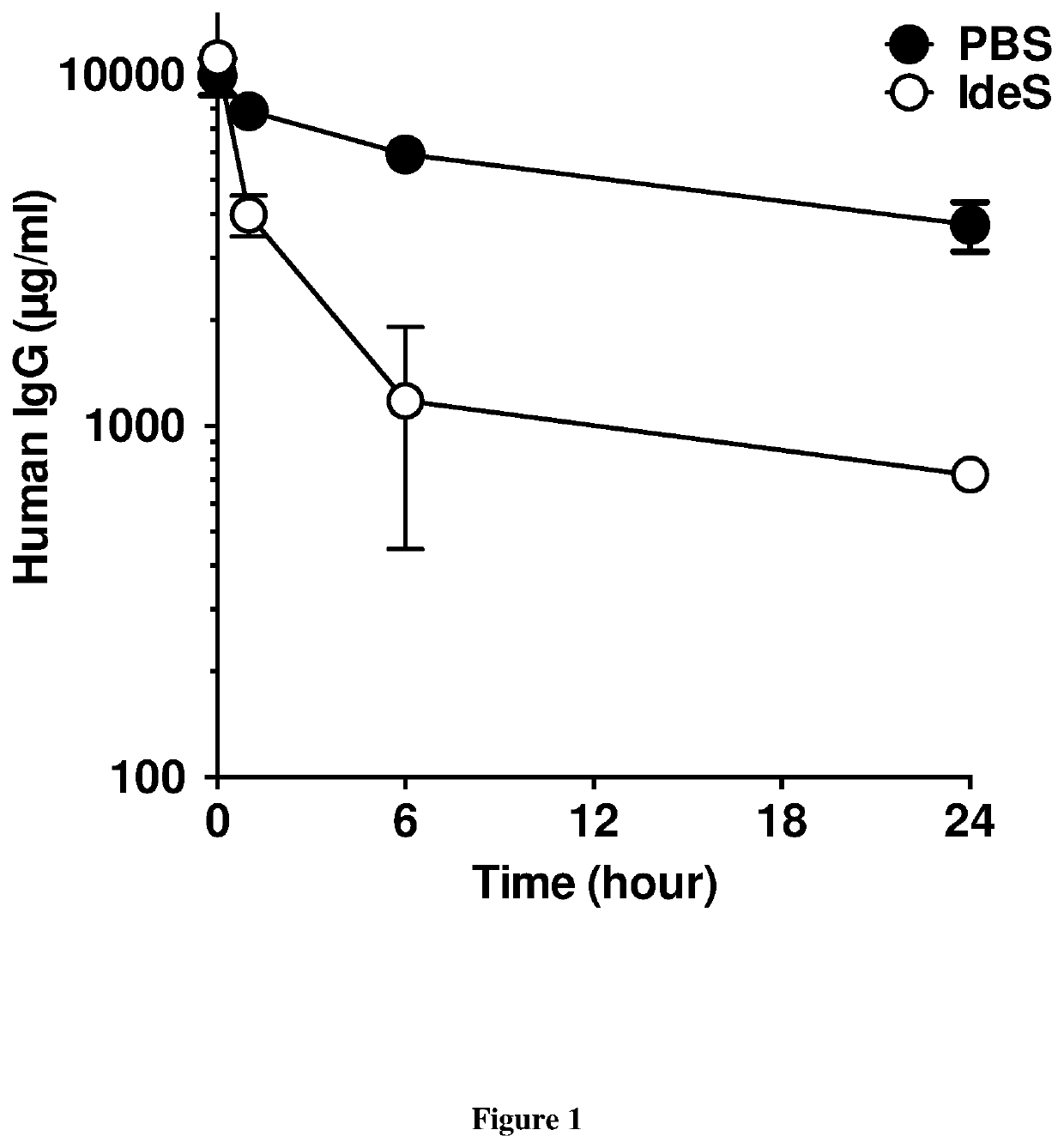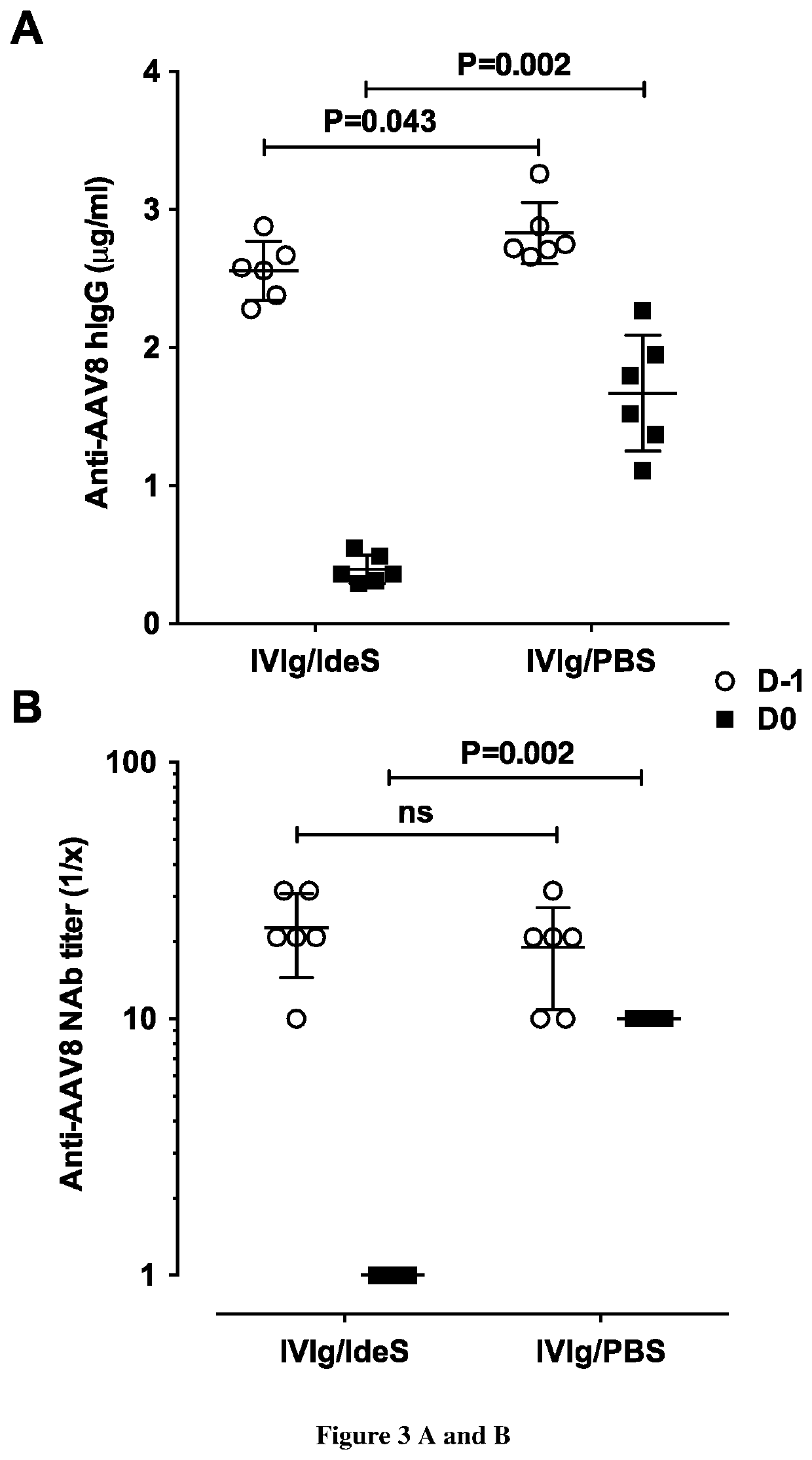Compositions and methods for increasing or enhancing transduction of gene therapy vectors and for removing or reducing immunoglobulins
a gene therapy and immunoglobulin technology, applied in the direction of drug compositions, peptides, enzymology, etc., can solve the problems of reducing the transduction efficiency of neutralizing antibodies, affecting the efficacy of aav gene therapy,
- Summary
- Abstract
- Description
- Claims
- Application Information
AI Technical Summary
Benefits of technology
Problems solved by technology
Method used
Image
Examples
example 1
Materials & Methods
AAV Vectors
[0320]AAV vectors were prepared as previously described (Ayuso et al. (2010) Gene Ther. 17, 503-10). Genome-containing vectors were produced in roller bottles following a triple transfection protocol with cesium chloride gradient purification (Ayuso et al. (2010)). The AAV vector titration was performed by real time PCR (qPCR) performed in ABI PRISM 7900 HT Sequence Detector using Absolute ROX mix (Taqman, Thermo Fisher Scientific, Waltham, Mass.), except for empty capsids that were titrated by SDS-PAGE followed by silver staining and quantification by densitometry against an AAV capsid used as a standard. For the in vitro neutralization assay, an AAV8 vector encoding luciferase (AAV8-Luc) was used as reporter as previously described (Miao et al. (2006) Blood. 108, 19-27). The AAV vectors used in the in vivo experiments expressed human FIX or Gaussia luciferase, under the control of a liver-specific promoter (Manno et al. (2006); Mingozzi et al. (2013) ...
example 2
[0337]Results with AAV8
[0338]We first investigated whether IdeS hydrolyses human IgG in vivo following passive immunization of wild-type mice, i.e., in a context where endogenous mouse IgG are present. Wild-type mice were injected with human IgG (IVIg) and 30 min later with IdeS. Intact human IgG were then tested in the serum collected 1, 6 and 24 hours later (FIG. 1). Levels of human IgG in non-treated mice demonstrated a progressive decline with time from 9.9±1.2 mg / mL (mean±SD) at 0 hr to 3.7±0.6 mg / mL at 24 hr, concordant with the half-life of human IgG in mice (Roopenian et al. (2003) J Immunol. 170, 3528-33). In contrast, human IgG in IdeS-treated mice demonstrated a rapid elimination from 11.1±1.0 mg / mL at 0 hr to 0.7±0.03 mg / mL at 24 hr. Treatment with IdeS thus resulted in a 5-fold decrease in the concentration of human IgG both 6 and 24 hr after injection.
[0339]To investigate the capacity of IdeS to reduce the levels of anti-AAV8 IgG in vivo, we used a passive immunization...
example 3
[0343]Results with AAV2 and AAV9
[0344]Anti-AAV2 and anti-AAV9 IgG and NAbs were measured in serum prepared from blood collected after the reconstitution of wild-type mice with 9 mg human IgG (D−1+15 min) and after the injection of IdeS (250 IU or 500 IU, for AAV2 or AAV9 respectively) or PBS (D0) (FIG. 2). IVIg contained substantial levels of functionally relevant anti-AAV2 and anti-AAV9 IgG, as detected both in ELISA (FIG. 3C, anti-AAV2 IgG 9.05±1.20 μg / mL and 8.92±0.63 μg / mL, means±SD; FIG. 3E, anti-AAV9 IgG 5.51±0.492 μg / mL and 5.145±0.691 μg / mL, for Groups 1 and 2, respectively) and in a neutralization assay (FIG. 3D, 1:886 and 1:772 [range: 1:316 to 1000] anti-AAV2 NAb titer; FIG. 3F, 1:15.4 and 1:24.4 [range: 1:10 to 31.6] anti-AAV9 NAb titer, for Groups 1 and 2 respectively). The injection of IdeS resulted in a drastic decrease in circulating levels of anti-AAV2 and AAV9 IgG. The decrease in anti-AAV2 IgG was 6 fold (1.51±0.31 μg / mL and 4.58±0.45 μg / mL, for Groups 1 and 2, re...
PUM
| Property | Measurement | Unit |
|---|---|---|
| molecular weight | aaaaa | aaaaa |
| average molecular weight | aaaaa | aaaaa |
| average molecular weight | aaaaa | aaaaa |
Abstract
Description
Claims
Application Information
 Login to View More
Login to View More - R&D Engineer
- R&D Manager
- IP Professional
- Industry Leading Data Capabilities
- Powerful AI technology
- Patent DNA Extraction
Browse by: Latest US Patents, China's latest patents, Technical Efficacy Thesaurus, Application Domain, Technology Topic, Popular Technical Reports.
© 2024 PatSnap. All rights reserved.Legal|Privacy policy|Modern Slavery Act Transparency Statement|Sitemap|About US| Contact US: help@patsnap.com










